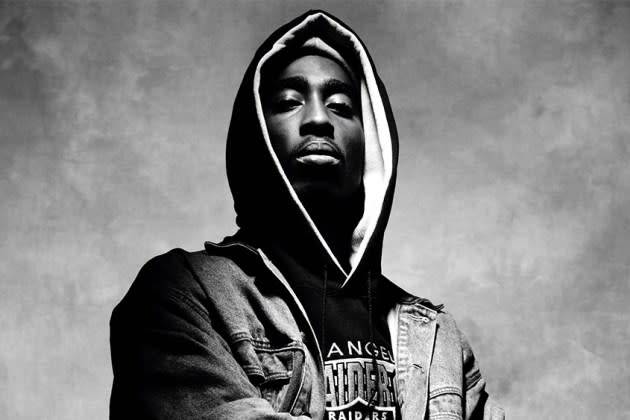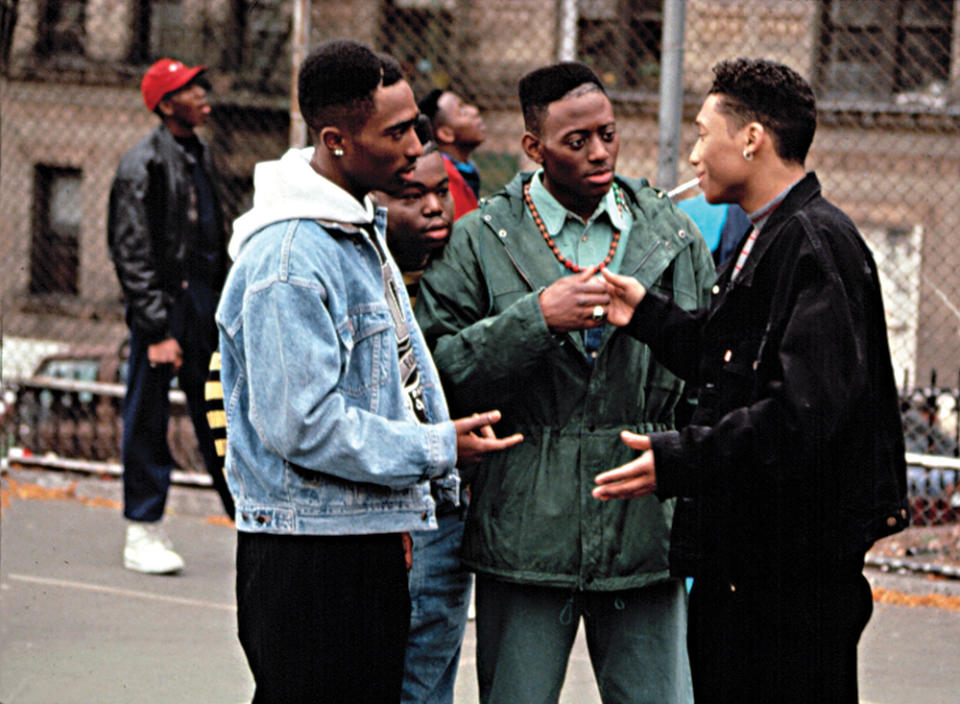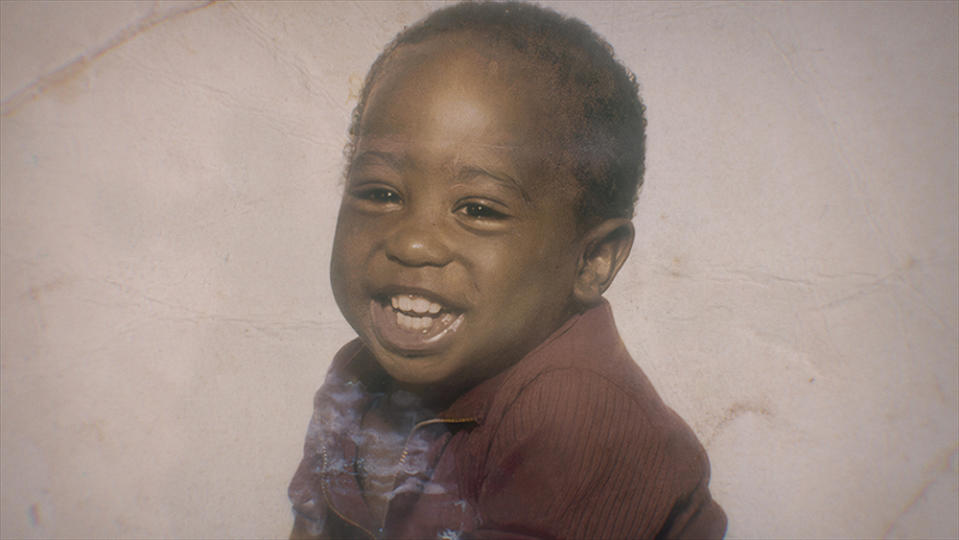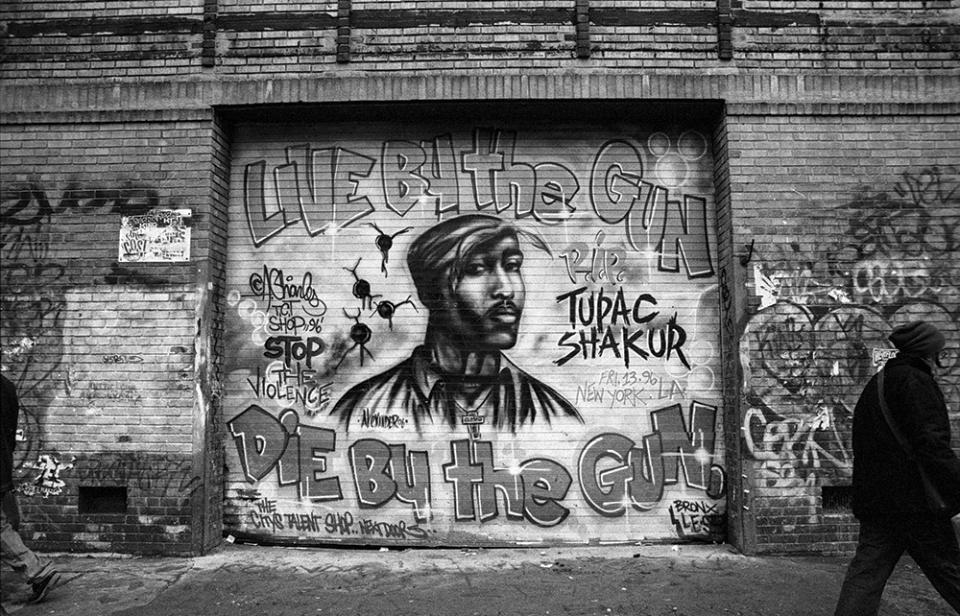Tupac’s Legacy as a Complicated Trailblazer Remembered as the Rapper-Actor Receives Hollywood Walk of Fame Honor
- Oops!Something went wrong.Please try again later.
- Oops!Something went wrong.Please try again later.
- Oops!Something went wrong.Please try again later.

On April 15, 2012, 2Pac made his debut appearance at the Coachella Valley Music & Arts Festival. At this point, it had been 16 years since Tupac Amaru Shakur had been murdered on the streets of Las Vegas at the age of 25. And yet there he was onstage, his holographic likeness projected with uncanny vividness alongside his onetime collaborators and labelmates Snoop Dogg and Dr. Dre, whom he now appeared to be speaking to and trading bars with in front of an audience of 80,000.
As the first performance of its kind, the 2Pac hologram became national news, and sparked worries that a wave of holo-tours, featuring ghostly apparitions of long dead stars, would soon be filling festival grounds and amphitheaters. Aside from a few one-offs, however, this did not come to pass. And yet the 2Pac hologram still felt significant for a different reason. After a decade and a half of vault-clearing posthumous releases, books, documentaries, statues, shout-outs in hundreds of hip-hop songs, and murals in virtually every American city from the Bay Area and back down, Shakur’s iconography had long seemed at risk of swallowing the brilliant, infuriating, inspiring, complicated man himself, leaving only a depthless shadow behind.
More from Variety
Shakur is hardly the first generational superstar to see his legend come to overshadow his life and work after death, but few have made for such an awkward fit into the narrow, two-dimensional confines of icon-hood. Unquestionably one of the most significant artists of the late 20th century, Shakur was both a sensitive poet and a volatile provocateur. A liberatory prophet and an agent of chaos. A figure of conscience and empathy with a propensity for violence and self-sabotage. To reduce him to only one set of those attributes was to misunderstand what made him so special—few American icons make less sense as a simplified, sanitized symbol.
And yet, as the years go by and the veterans of hip-hop’s most important and tumultuous era settle into middle age, it feels as though his legacy is coming into sharper, more complete focus. Earlier this year, Allen Hughes’ FX docuseries “Dear Mama” offered a far-reaching study of Shakur’s life by focusing on his relationship with his mother, Afeni Shakur (herself a trailblazing figure of the Black liberation movement whose life would have been documentary-worthy even if her son had been a chiropractor). There are now courses dedicated to 2Pac in more than one college, and the growing library of Shakur studies offers plenty of space to explore the more obscure corners of his life and work. He’s already a Rock Hall inductee, and only the third rapper to have a song included in the Library of Congress’ National Recording Registry. And on June 7, Tupac Shakur will add another important notch to his legacy when he finally receives a star on the Hollywood Walk of Fame.

Considering how thoroughly he’s been dissected over the decades, it’s worth remembering just how exciting and anomalous a figure Shakur was when he emerged into popular consciousness. By the time he made his recorded debut in 1991, the golden age of hip-hop was in full bloom. LL Cool J had proven that rappers could be hearthrobs with pin-up photo spreads. N.W.A had raised the stakes on violent lyrical provocation, and showed just how lucrative it could be to do so. Groups like Public Enemy, X Clan and the Jungle Brothers had employed hip-hop as a vehicle for Black liberation. And Will Smith was on the cusp of proving that a rapper could cross over into a mainstream film and TV acting career. The possibilities for the young genre seemed limitless, and 2Pac was the first who seemed to embody all of these possibilities simultaneously, becoming the model of the modern hip-hop star in the process.
His style was always far too slippery to pigeonhole. He rapped with the cadences of a minister, equally comfortable with Gospel-style homilies or Old Testament brimstone, both righteous and otherwise. As a lyricist he was at home in a variety of registers, from the most plainspoken narratives and straightforward rhyme schemes, to dizzying explosions of alliteration and splatterpaint abstraction. Even just the timbre of his voice would inspire too many copycats to mention, though few managed to replicate the full-body commitment and hunger that powered his delivery. (As Shakur’s onetime mentor Shock G put it, “‘Pac rhymed from the pit of his stomach.”) Here was a man raised by a Black Panther, who grew up amidst the crushing danger and deprivation of the 1980s crack epidemic, all the while studying ballet and performing Lorraine Hansberry onstage—and all of these disparate life experiences would form the primary colors of his art.

After a short but significant stint as a dancer-rapper-roadie hybrid with Oakland’s Digital Underground, 2Pac made his solo debut as one of the first artists signed to the nascent label Interscope. Considering how quickly he would become a lightning rod for controversy, it’s striking how defiantly uncommercial much of 1991’s “2Pacalypse Now” sounds to modern ears. Impassioned, righteously political, and sometimes didactic, it was informed as much by the types of rhetoric Shakur might have absorbed from tales of his famous godparents, Geronimo Pratt and Assata Shakur, as it was by anything on rap radio rotation at the time. Listening to it today, it’s easy to understand why so many close to Shakur saw him as a budding revolutionary who also happened to rap, and why (in spite of his then relatively minor national profile) he made an easy target for Vice President Dan Quayle’s election-year cultural war soundbites.
Shakur crept much closer to the mainstream while keeping his politics intact on 1993’s “Strictly…,” incorporating a few doses of Digital Underground’s party funk and narrowing the gap between his Oakland-flavored style and that of hip-hop’s emerging power center just down the 5 Freeway in Los Angeles. (Although, at the time, Shakur still openly chafed at the label of “gangsta rapper.”) Film roles in “Juice” and “Poetic Justice” exposed his effortless charisma to an even broader audience, and within two years he had readied his first masterpiece. On “Me Against the World,” 2Pac offered the most coherent and complete portrait of the warring impulses that guided his art. It contained his greatest moments of tenderness and introspection, alongside blasts of aggression and an almost theatrical sense of fatalism. It was a remarkably mature work for a 23-year-old to have produced, capturing the intricacies of the artist’s inner struggles so incisively that a New York Times review compared it to St. Augustine’s “Confessions.”
It was also 2Pac’s first No. 1 album, although that accomplishment came with a major asterisk: by the time it was released, Shakur was in prison, recovering from five gunshot wounds. Indeed, the year preceding its release had been a period of almost unbelievable turmoil, encompassing Shakur’s shooting at New York’s Quad Studios and no less than three arrests, the most serious leading to a conviction for sexual abuse. Though Shakur always maintained his innocence of the latter charge, it was difficult to reconcile the endlessly empathetic narrator of “Dear Mama” with the man who was photographed spitting at reporters outside the courthouse where he was accused of sex crimes.
The last year of Shakur’s life would hardly make this any easier. Signing with Suge Knight’s infamous Death Row Records, propagating an alarming series of beefs with fellow rappers, and providing journalists with endless amounts of paranoid and polarizing pullquotes, post-prison 2Pac sometimes seemed almost unrecognizable to those who had followed him from early on. On the final album released in his lifetime, the 1996 double disc “All Eyez on Me,” Shakur’s heel-turn was complete, and his lyrics openly wallowed in violence, misogyny and hedonism with only fleeting hints of the social consciousness that had given his earlier work such a fascinating duality. Commercially, this was a savvy move—“Eyez” sold more than half a million copies in its first week, and produced his first and only No. 1 singles. And yet, however you felt about it, nothing about that album seemed remotely calculated or opportunistic. Shakur’s inchoate rage at his growing roster of enemies here felt every bit as sincere as it did when it was directed at more deserving targets. His rhymes were as sharp as they had ever been, his commitment to his craft just as obvious. When it came to his music, 2Pac seemed constitutionally incapable of bullshit. All of this was genuinely 2Pac, too.
And this was the image of 2Pac that persisted in the weeks following his still unsolved murder. It might have even remained so, had he not left a frankly astonishing amount of unreleased and unfinished material behind, which would gradually reveal even more shades of his ever-mutable personality. Tracks like “Hail Mary” and “Me and My Girlfriend” from his first posthumously released album would become gangsta rap holy scripture. A collection of Shakur’s pre-fame poetry would prove a bestseller, with its glimpses at Shakur’s most sensitive and vulnerable side endearing him to future generations of teenage romantics. As the years went by, the constant drip of posthumous releases—some augmented with contemporary production, and featuring beyond-the-grave collaborations—began to constitute its own shadow discography, an attempt to project a comforting and familiar version of Shakur onto the present day, as though anyone could have possibly predicted where this constantly confounding man might have set his sights next.
At a certain point, as memories of his tumultuous life began to calcify into myth, his significance became more diffuse. The rapper who had once provoked condemnation from politicians on both sides of the aisle was now claimed as a personal favorite by everyone from Kamala Harris to Marco Rubio. The Vatican included one of his songs on an official playlist, alongside Gregorian chanting and sermon snippets from the Pope. Kendrick Lamar structured his landmark “To Pimp a Butterfly” album around an imagined conversation with his departed idol. And the late Nipsey Hussle, when faced with a similar crossroads between pursuing commercial success and dedicating his talents to community renewal, took both inspiration and notes of caution from Shakur’s example. Whatever you wanted Shakur to symbolize, there was probably more than enough evidence to support your reading.

But one of the reasons that Shakur’s popularity remains so constant is that he resists our need for cleanly demarcated heroes and villains. Shakur once courageously put his life and his freedom on the line to defend a total stranger from a beating at the hands of two off-duty Atlanta cops. Years later, he would do the same to pointlessly avenge a petty beef on the floor of a Las Vegas casino. “Keep Ya Head Up” is a quintessential 2Pac song. So is “Hit ‘Em Up.” To love 2Pac is to constantly wrestle with these contradictions, and it requires often disagreeing with him, and sometimes being disgusted with him. One imagines he would have expected no less from himself.
It’s often said that Shakur seemed to pack a whole year’s worth of living into every week of his brief life, and taking in the scope of his creative output—from his studio albums to his posthumously released material, film roles, TV appearances, drawings, screenplays, poetry, manifestos—it’s difficult to process that all of this came from a professional career which only lasted five years. He pondered his own mortality so often that his premature death later came to seem preordained. But the truth is that it wasn’t, and a quarter-century was a cruelly short allotment of life for someone with Shakur’s energy and ambitions. Given more time, would he have managed to reconcile these fascinating contradictions at the center of his life and his art? Or, ever restless, would he simply have found more impossible questions to ask, more contradictions with which to grapple? He certainly left us with more than enough to sort out on our own.
Best of Variety
Sign up for Variety’s Newsletter. For the latest news, follow us on Facebook, Twitter, and Instagram.

